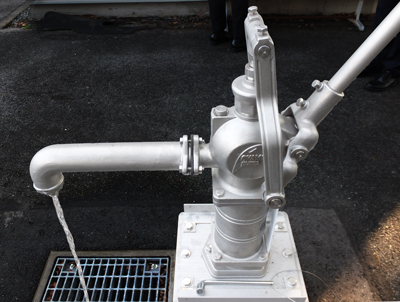Research News
Nov 4, 2022
Water cutoff countermeasures using disaster emergency wells
Finding the contribution of emergency well to emergency water supply during chaotic conditions
In recent years, large-scale natural disasters around the world have caused a series of water cutoffs, which seriously affect the quality of life of disaster victims. To address this, there has been growing interest in the viability of disaster emergency wells to mitigate water cutoffs during natural disasters.

A research group led by Professor Takahiro Endo from the Graduate School of Sustainable System Sciences at Osaka Metropolitan University conducted surveys of local well owners who supplied groundwater (91 organizations) and welfare facilities representing water users (328 facilities) that were affected by the 2016 Kumamoto Earthquake. The surveys clarified the status of groundwater use after the earthquake for suppliers and users, as well as policy issues surrounding the use of emergency wells.
“Groundwater has been considered an important resource for both industrial production and the natural environment, but this research has newly clarified that groundwater is also a disaster prevention resource,” explained Professor Endo.
Although there have been previous studies of groundwater use in disaster, most of these studies assessed future disasters, such as groundwater exploration techniques and estimation of groundwater availability in the event of water supply cutoffs. Groundwater is primarily provided during the chaotic period immediately after a disaster through private wells, which are scattered throughout the affected area. This makes keeping official records of groundwater usage difficult. So, up until now, emergency well usage after earthquakes was not thoroughly understood.
The surveys found that the use of emergency wells complemented the Kumamoto city government’s emergency water supply by speeding up water delivery and improving access to water. On the other hand, a reasonable number of welfare facilities did not use water from emergency wells, even when they were nearby. This indicates that publicizing emergency well locations is an important policy issue.
“This new data is very useful for city governments who have already installed or are considering installing emergency wells in the near future,” Professor Endo concluded.
Funding
The research project on groundwater use in an emergency is supported by the Council for Science, Technology, and Innovation (CSTI), Cross-ministerial Strategic Innovation Promotion Program (SIP), Enhancement of National Resilience against Natural Disasters (Funding agency: National Research Institute for Earth Science and Disaster Resilience). This research is also partially supported by the Japan Society for the Promotion of Science KAKENHI (Grant-in-Aid for Challenging Exploratory Research) grant numbers 20H04392 and 22K12498.
Paper Information
Journal: Hydrogeology Journal
Title: Groundwater as emergency water supply: case study of the 2016 Kumamoto Earthquake, Japan
DOI: 10.1007/s10040-022-02547-9
Author: Takahiro Endo, Tomoki Iizuka, Hitomi Koga, Nahoko Hamada
Publish: October 17, 2022
URL: https://doi.org/10.1007/s10040-022-02547-9
Contribution to SDGs

11: Sustainable Cities and Communities
Contact
Graduate School of Sustainable System Sciences
Professor Takahiro ENDO
E-mail: endo[at]omu.ac.jp
*Please change [at] to @.
SDGs
